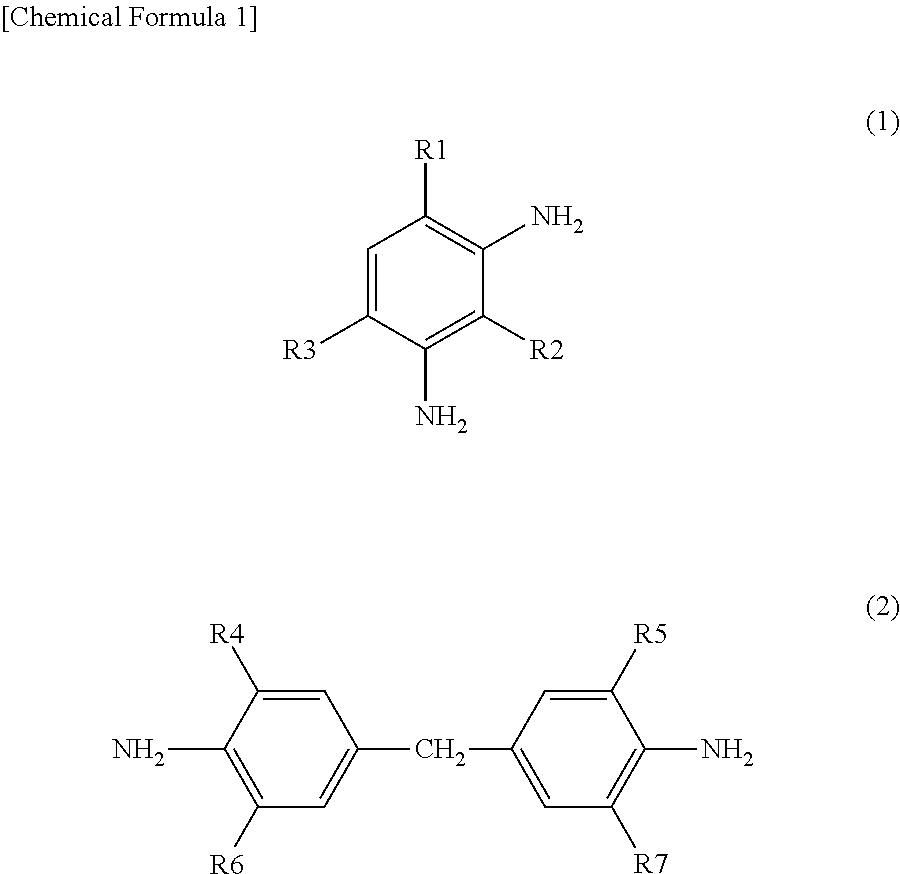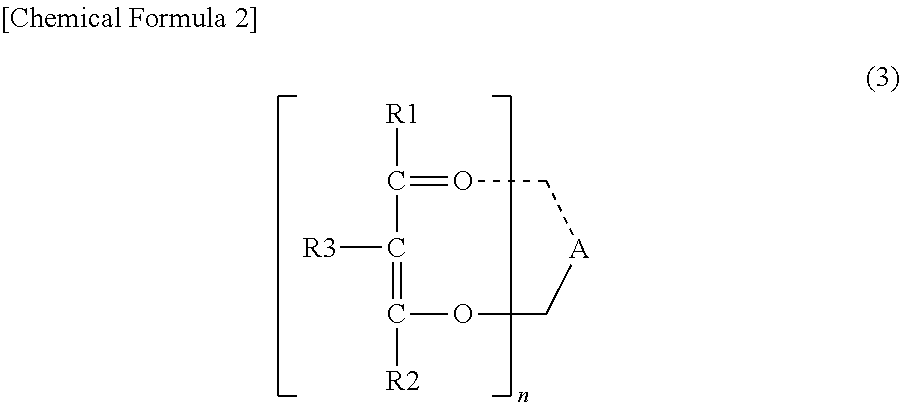Epoxy resin composition
a technology of epoxy resin and aromatic amine, which is applied in the direction of synthetic resin layered products, transportation and packaging, and semiconductor/solid-state device details, etc. it can solve the problems of reducing productivity, consuming a great deal of energy, and needing prolonged cure of conventional aromatic amine-curable epoxy resin compositions, so as to reduce the thermal stress of cured products, the application of compositions of epoxy compounds with aromatic amines is extended, and the thermal cure state is stable
- Summary
- Abstract
- Description
- Claims
- Application Information
AI Technical Summary
Benefits of technology
Problems solved by technology
Method used
Image
Examples
examples 6 to 12
[0065]There are given in Table 2 the measured results of the stability and acceleratability of the epoxy resin compositions obtained by blending 100 parts by weight of EXA-830LVP (expressed as BisF in the table), 30 parts by weight of EKW, and widely varied amounts of Mg(II) acetylacetonate added as a cure accelerator, and Tg of cured products after cure at 160° C. for 90 minutes. The evaluation methods used are the same as those of Examples 1 to 5.
TABLE 2ExampleExampleExampleExampleExampleExampleExample6789101112BisF100100100100100100100EKW30303030303030Mg (II) AcAc0.10.41351015Stability1.31.61.92.34.16.68.5Acceleratability125° C.1.73.35.46.38.08.28.8160° C.1.53.14.89.37.07.67.1Tg (° C.)138140142136143144142
[0066]The results given in Table 2 show that a cure acceleration effect was revealed by addition of Mg(II) acetylacetonate even in only a small amount as much as 0.1 parts by weight and stability was observed up to 15 parts by weight. A preferable amount to be added is considere...
examples 13 to 15
[0067]Mn(III) acetylacetonate (expressed as Mn(AcAc)3 in the table), Mn(II) acetylacetonate (expressed as Mn(AcAc)2 in the table), and Co (III) acetylacetonate (expressed as Co (AcAc)3 in the table) were used as a cure accelerator together with Mg(II) acetylacetonate (expressed as Mg(AcAc)2 in the table). The stability, acceleratability, and Tg of the epoxy resin composition including 100 parts by weight of EXA-830LVP (expressed as BisF in the table) and 30 parts by weight of EKW were measured in the same manner as in Examples 1 to 5. The results are shown in Table 3.
TABLE 3Example 13Example 14Example 15BisF100 100 100 EKW30 30 30 Cure acceleratorMgMnMgMnMgCo(part by weight)(AcAc)2(AcAc)3(AcAc)2(AcAc)2(AcAc)2(AcAc)32.50.52.50.52.01.0Stability6.03.32.8Acceleratability125° C.8.97.69.6160° C.6.36.36.5Tg (° C.)143 141 142
[0068]As shown by the results given in Table 3, it is possible to employ Mg (II) acetylacetonate as a main cure accelerator and also employ acetylacetonates o...
examples 17 to 18
, COMPARATIVE EXAMPLES 13 TO 15
[0071]Comparative Example 13 is an epoxy-aromatic amine composition that includes 100 parts by weight of a bisphenol F epoxy resin (henceforth expressed as BisF) and 30 parts by weight of diethyldiaminotoluene (henceforth expressed as EKW) and contains no cure accelerator, and Examples 17, 18, Comparative Examples 14, 15 are epoxy-aromatic amine compositions each containing 3 parts by weight of an acetylacetonate of alkali or alkaline earth group metal given in the table as a cure accelerator, each having been prepared by fully dispersing and stirring those ingredients.
[0072]The bisphenol F epoxy compound used was EXA-830LVP (average weight per epoxy equivalent: 161; viscosity at 25° C.: 2 Pa·s) produced by DIC Corporation, the EKW was diethyldiaminotoluene produced by Japan Epoxy Resin Corporation (average amine value: 631 KOHmg / g; viscosity at 25° C.: 0.3 Pa·s), the Mg(II) acetylacetonate, Mg(II) acetylacetonate hydrate, and Ca(II) acetylacetonate we...
PUM
| Property | Measurement | Unit |
|---|---|---|
| temperatures | aaaaa | aaaaa |
| temperature | aaaaa | aaaaa |
| temperature | aaaaa | aaaaa |
Abstract
Description
Claims
Application Information
 Login to View More
Login to View More - R&D
- Intellectual Property
- Life Sciences
- Materials
- Tech Scout
- Unparalleled Data Quality
- Higher Quality Content
- 60% Fewer Hallucinations
Browse by: Latest US Patents, China's latest patents, Technical Efficacy Thesaurus, Application Domain, Technology Topic, Popular Technical Reports.
© 2025 PatSnap. All rights reserved.Legal|Privacy policy|Modern Slavery Act Transparency Statement|Sitemap|About US| Contact US: help@patsnap.com


